Carbapenemase-Producing Klebsiella pneumoniae in COVID-19 Intensive Care Patients: Identification of IncL-VIM-1 Plasmid in Previously Non-Predominant Sequence Types
Abstract
1. Introduction
2. Results
2.1. Bacterial Isolates, Patients, and Carbapenemase Types
2.2. Antibiotic Susceptibility Testing
2.3. Phylogenetic Analysis of CP-Kpn
2.4. Identification and Distribution of Resistance and Virulence Genes
2.5. Characterization of Plasmids Harboring the blaVIM-1 Gene
3. Discussion
4. Materials and Methods
4.1. Study Design and CP-Kpn Isolates
4.2. Drug Susceptibility Testing
4.3. Genomic Library Preparation and DNA Sequence Analysis
4.4. Phylogenetic Analyses
4.5. Analysis of Antimicrobial Resistance, Virulence Genes, and Capsular Locus
4.6. Characterization of Plasmids Carrying Carbapenemase Genes
Supplementary Materials
Author Contributions
Funding
Institutional Review Board Statement
Informed Consent Statement
Data Availability Statement
Acknowledgments
Conflicts of Interest
References
- World Health Organization. COVID-19 Weekly Epidemiological Update; World Health Organization: Geneva, Switzerland, 2022.
- Zhu, X.; Ge, Y.; Wu, T.; Zhao, K.; Chen, Y.; Wu, B.; Zhu, F.; Zhu, B.; Cui, L. Co-infection with respiratory pathogens among COVID-2019 cases. Virus Res. 2020, 285, 198005. [Google Scholar] [CrossRef] [PubMed]
- Cantón, R.; Gijón, D.; Ruiz-Garbajosa, P. Antimicrobial resistance in ICUs: An update in the light of the COVID-19 pandemic. Curr. Opin. Crit. Care 2020, 26, 433–441. [Google Scholar] [CrossRef]
- Tacconelli, E.; Carrara, E.; Savoldi, A.; Harbarth, S.; Mendelson, M.; Monnet, D.L.; Pulcini, C.; Kahlmeter, G.; Kluytmans, J.; Carmeli, Y.; et al. Discovery, research, and development of new antibiotics: The WHO priority list of antibiotic-resistant bacteria and tuberculosis. Lancet Infect. Dis. 2018, 18, 318–327. [Google Scholar] [CrossRef]
- Cañada-García, J.E.; Moure, Z.; Sola-Campoy, P.J.; Delgado-Valverde, M.; Cano, M.E.; Gijón, D.; González, M.; Gracia-Ahufinger, I.; Larrosa, N.; Mulet, X.; et al. CARB-ES-19 Multicenter Study of Klebsiella pneumoniae and Escherichia coli From All Spanish Provinces Reveals Interregional Spread of High-Risk Clones Such as ST307/OXA-48 and ST512/KPC-3. Front. Microbiol. 2022, 13, 1–13. [Google Scholar] [CrossRef] [PubMed]
- David, S.; Reuter, S.; Harris, S.R.; Glasner, C.; Feltwell, T.; Argimon, S.; Abudahab, K.; Goater, R.; Giani, T.; Errico, G.; et al. Epidemic of carbapenem-resistant Klebsiella pneumoniae in Europe is driven by nosocomial spread. Nat. Microbiol. 2019, 4, 1919–1929. [Google Scholar] [CrossRef] [PubMed]
- Ali, M.; Lucien, B.; Canarie, M.F.; Kilgore, P.E.; Jean-denis, G.; Fénélon, N.; Pierre, M.; Cerpa, M.; Joseph, G.A.; Maki, G.; et al. Antibiotics and antimicrobial resistance in the COVID-19 era: Perspective from resource-limited settings. Int. J. Infect. Dis. 2021, 104, 250–254. [Google Scholar] [CrossRef]
- Pascale, R.; Bussini, L.; Gaibani, P.; Bovo, F.; Fornaro, G.; Lombardo, D.; Ambretti, S.; Pensalfine, G.; Appolloni, L.; Bartoletti, M.; et al. Carbapenem-resistant bacteria in an intensive care unit during the coronavirus disease 2019 (COVID-19) pandemic: A multicenter before-and-after cross-sectional study. Infect. Control Hosp. Epidemiol. 2022, 43, 461–466. [Google Scholar] [CrossRef]
- Kariyawasam, R.M.; Julien, D.A.; Jelinski, D.C.; Larose, S.L.; Rennert-May, E.; Conly, J.M.; Dingle, T.C.; Chen, J.Z.; Tyrrell, G.J.; Ronksley, P.E.; et al. Antimicrobial resistance (AMR) in COVID-19 patients: A systematic review and meta-analysis (November 2019–June 2021). Antimicrob. Resist. Infect. Control 2022, 11, 45. [Google Scholar] [CrossRef]
- Schürch, A.C.; Arredondo-Alonso, S.; Willems, R.J.L.; Goering, R.V. Whole genome sequencing options for bacterial strain typing and epidemiologic analysis based on single nucleotide polymorphism versus gene-by-gene–based approaches. Clin. Microbiol. Infect. 2018, 24, 350–354. [Google Scholar] [CrossRef]
- Clancy, C.; Nguyen, H. COVID-19, superinfections and antimicrobial development: What can we expect? Clin. Infect. Dis. 2020, 46, 1–17. [Google Scholar] [CrossRef]
- Bengoechea, J.A.; Bamford, C.G. SARS-CoV-2, bacterial co-infections, and AMR: The deadly trio in COVID-19? EMBO Mol. Med. 2020, 12, 10–13. [Google Scholar] [CrossRef] [PubMed]
- Doi, Y. Treatment Options for Carbapenem-resistant Gram-negative Bacterial Infections. Clin. Infect. Dis. 2019, 69, S565–S575. [Google Scholar] [CrossRef] [PubMed]
- Rawson, T.M.; Zhu, N.; Ranganathan, N.; Gilchrist, M.; Satta, G.; Cooke, G.; Holmes, A. Bacterial and fungal co-infection in individuals with coronavirus: A rapid review to support COVID-19 antimicrobial prescribing Timothy. Clin. Infect. Dis. 2020, 71, 2459–2468. [Google Scholar] [CrossRef]
- Tiri, B.; Sensi, E.; Marsiliani, V.; Cantarini, M.; Priante, G.; Vernelli, C.; Martella, L.A.; Costantini, M.; Mariottini, A.; Andreani, P.; et al. Antimicrobial stewardship program, COVID-19, and infection control: Spread of carbapenem-resistant Klebsiella pneumoniae colonization in ICU COVID-19 patients. What did not work? J. Clin. Med. 2020, 9, 2744. [Google Scholar] [CrossRef]
- Gomez-Simmonds, A.; Annavajhala, M.K.; McConville, T.H.; Dietz, D.E.; Shoucri, S.M.; Laracy, J.C.; Rozenberg, F.D.; Nelson, B.; Greendyke, W.G.; Furuya, E.Y.; et al. Carbapenemase-producing Enterobacterales causing secondary infections during the COVID-19 crisis at a New York City hospital. J. Antimicrob. Chemother. 2021, 76, 380–384. [Google Scholar] [CrossRef]
- Shbaklo, N.; Corcione, S.; Vicentini, C.; Giordano, S.; Fiorentino, D.; Bianco, G.; Cattel, F.; Cavallo, R.; Zotti, C.M.; De Rosa, F.G. An Observational Study of MDR Hospital-Acquired Infections and Antibiotic Use during COVID-19 Pandemic: A Call for Antimicrobial Stewardship Programs. Antibiotics 2022, 11, 695. [Google Scholar] [CrossRef]
- Grundmann, H.; Glasner, C.; Albiger, B.; Aanensen, D.M.; Tomlinson, C.T.; Andrasević, A.T.; Cantón, R.; Carmeli, Y.; Friedrich, A.W.; Giske, C.G.; et al. Occurrence of carbapenemase-producing Klebsiella pneumoniae and Escherichia coli in the European survey of carbapenemase-producing Enterobacteriaceae (EuSCAPE): A prospective, multinational study. Lancet Infect. Dis. 2017, 17, 153–163. [Google Scholar] [CrossRef]
- Oteo, J.; Ortega, A.; Bartolomé, R.; Bou, G.; Conejo, C.; Fernández-Martínez, M.; González-López, J.J.; Martínez-García, L.; Martínez-Martínez, L.; Merino, M.; et al. Prospective multicenter study of carbapenemase-producing Enterobacteriaceae from 83 hospitals in Spain reveals high in vitro susceptibility to colistin and meropenem. Antimicrob. Agents Chemother. 2015, 59, 3406–3412. [Google Scholar] [CrossRef]
- Peirano, G.; Chen, L.; Kreiswirth, B.N.; Pitout, J.D.D. Emerging Antimicrobial-Resistant High-Risk Klebsiella pneumoniae Clones ST307 and ST147. Antimicrob. Agents Chemother. 2020, 64, 1–14. [Google Scholar] [CrossRef]
- Piazza, A.; Comandatore, F.; Romeri, F.; Brilli, M.; Dichirico, B.; Ridolfo, A.; Antona, C.; Bandi, C.; Gismondo, M.R.; Rimoldi, S.G. Identification of blaVIM-1 gene in ST307 and ST661 Klebsiella pneumoniae clones in Italy: Old acquaintances for new combinations. Microb. Drug Resist. 2019, 25, 787–790. [Google Scholar] [CrossRef] [PubMed]
- Strydom, K.A.; Chen, L.; Kock, M.M.; Stoltz, A.C.; Peirano, G.; Nobrega, D.B.; Lowe, M.; Ehlers, M.M.; Mbelle, N.M.; Kreiswirth, B.N.; et al. Klebsiella pneumoniae ST307 with OXA-181: Threat of a high-risk clone and promiscuous plasmid in a resource-constrained healthcare setting. J. Antimicrob. Chemother. 2020, 75, 896–902. [Google Scholar] [CrossRef] [PubMed]
- Cao, X.; Zhong, Q.; Guo, Y.; Hang, Y.; Chen, Y.; Fang, X.; Xiao, Y.; Zhu, H.N.; Luo, H.; Yu, F.; et al. Emergence of the coexistence of mcr-1, blaNDM-5, and blaCTX-M-55 in Klebsiella pneumoniae ST485 clinical isolates in China. Infect. Drug Resist. 2021, 14, 3449–3458. [Google Scholar] [CrossRef] [PubMed]
- Mendes, G.; Ramalho, J.F.; Bruschy-fonseca, A.; Lito, L.; Duarte, A.; Melo-cristino, J.; Caneiras, C. Whole-Genome Sequencing Enables Molecular Characterization of Non-Clonal Group 258 High-Risk Clones (ST13, ST17, ST147 and ST307) Among Carbapenem-Resistant Klebsiella pneumoniae From a Tertiary University Hospital Centre in Portugal. Microorganisms 2022, 10, 416. [Google Scholar] [CrossRef]
- He, J.; Du, X.; Zeng, X.; Moran, R.A.; van Schaik, W.; Zou, Q.; Yu, Y.; Zhang, J.; Hua, X. Phenotypic and Genotypic Characterization of a Hypervirulent Carbapenem-Resistant Klebsiella pneumoniae ST17-KL38 Clinical Isolate Harboring the Carbapenemase IMP-4. Microbiol. Spectr. 2013, 65, 585–593. [Google Scholar] [CrossRef]
- Leangapichart, T.; Lunha, K.; Jiwakanon, J.; Angkititrakul, S.; Järhult, J.D.; Magnusson, U.; Sunde, M. Characterization of Klebsiella pneumoniae complex isolates from pigs and humans in farms in Thailand: Population genomic structure, antibiotic resistance and virulence genes. J. Antimicrob. Chemother. 2021, 76, 2012–2016. [Google Scholar] [CrossRef]
- Piccirilli, A.; Cherubini, S.; Azzini, A.M.; Tacconelli, E.; Lo Cascio, G.; Maccacaro, L.; Bazaj, A.; Naso, L.; Amicosante, G.; Perilli, M. Whole-genome sequencing (WGS) of carbapenem-resistant K. pneumoniae isolated in long-term care facilities in the northern italian region. Microorganisms 2021, 9, 1985. [Google Scholar] [CrossRef]
- Vázquez-Ucha, J.C.; Seoane-Estévez, A.; Rodiño-Janeiro, B.K.; González-Bardanca, M.; Conde-Pérez, K.; Martínez-Guitián, M.; Alvarez-Fraga, L.; Arca-Suárez, J.; Lasarte-Monterrubio, C.; Gut, M.; et al. Activity of imipenem/relebactam against a Spanish nationwide collection of carbapenemase-producing Enterobacterales. J. Antimicrob. Chemother. 2021, 76, 1498–1510. [Google Scholar] [CrossRef]
- Grau, S.; Hernández, S.; Echeverría-Esnal, D.; Almendral, A.; Ferrer, R.; Limón, E.; Horcajada, J.P. Antimicrobial consumption among 66 acute care hospitals in catalonia: Impact of the COVID-19 pandemic. Antibiotics 2021, 10, 943. [Google Scholar] [CrossRef]
- Karaiskos, I.; Lagou, S.; Pontikis, K.; Rapti, V.; Poulakou, G. The “Old” and the “New” antibiotics for MDR Gram-negative pathogens: For whom, when, and how. Front. Public Health 2019, 7, 1–25. [Google Scholar] [CrossRef]
- Villa, J.; Viedma, E.; Brañas, P.; Orellana, M.A.; Otero, J.R.; Chaves, F. Multiclonal spread of VIM-1-producing Enterobacter cloacae isolates associated with In624 and In488 integrons located in an IncHI2 plasmid. Int. J. Antimicrob. Agents 2014, 43, 451–455. [Google Scholar] [CrossRef]
- Villa, J.; Arana, D.M.; Viedma, E.; Perez-Montarelo, D.; Chaves, F. Characterization of mobile genetic elements carrying VIM-1 and KPC-2 carbapenemases in Citrobacter freundii isolates in Madrid. Int. J. Med. Microbiol. 2017, 307, 340–345. [Google Scholar] [CrossRef] [PubMed]
- Pérez-Viso, B.; Hernández-García, M.; Ponce-Alonso, M.; Morosini, M.I.; Ruiz-Garbajosa, P.; del Campo, R.; Cantón, R. Characterization of carbapenemase-producing Serratia marcescens and whole-genome sequencing for plasmid typing in a hospital in Madrid, Spain (2016-18). J. Antimicrob. Chemother. 2021, 76, 110–116. [Google Scholar] [CrossRef]
- Pitout, J.D.D.; Peirano, G.; Kock, M.M.; Strydom, K.A.; Matsumura, Y. The global ascendency of OXA-48-type carbapenemases. Clin. Microbiol. Rev. 2020, 33, 1–48. [Google Scholar] [CrossRef]
- Lázaro-Perona, F.; Sotillo, A.; Troyano-Hernáez, P.; Gómez-Gil, R.; de la Vega-Bueno, Á.; Mingorance, J. Genomic path to pandrug resistance in a clinical isolate of Klebsiella pneumoniae. Int. J. Antimicrob. Agents 2018, 52, 713–718. [Google Scholar] [CrossRef]
- International Organization for Standardization (ISO) Clinical Laboratory Testing and in Vitro Diagnostic Test Systems—Susceptibility Testing of Infectious Agents and Evaluation of Performance of Antimicrobial Susceptibility Test Devices—Part 1. Available online: https://www.iso.org/standard/41630.html (accessed on 15 November 2022).
- Wick, R.R.; Judd, L.M.; Gorrie, C.L.; Holt, K.E. Unicycler: Resolving bacterial genome assemblies from short and long sequencing reads. PLoS Comput. Biol. 2017, 13, 1–22. [Google Scholar] [CrossRef] [PubMed]
- Seemann, T. Prokka: Rapid prokaryotic genome annotation. Bioinformatics 2014, 30, 2068–2069. [Google Scholar] [CrossRef] [PubMed]
- Hunt, M.; Mather, A.E.; Sánchez-Busó, L.; Page, A.J.; Parkhill, J.; Keane, J.A.; Harris, S.R. ARIBA: Rapid antimicrobial resistance genotyping directly from sequencing reads. Microb. Genomics 2017, 3, e000131. [Google Scholar] [CrossRef]
- Gastmeier, P.; Schwab, F.; Bärwolff, S.; Rüden, H.; Grundmann, H. Correlation between the genetic diversity of nosocomial pathogens and their survival time in intensive care units. J. Hosp. Infect. 2006, 62, 181–186. [Google Scholar] [CrossRef]
- Lam, M.M.C.; Wick, R.R.; Watts, S.C.; Cerdeira, L.T.; Wyres, K.L.; Holt, K.E. A genomic surveillance framework and genotyping tool for Klebsiella pneumoniae and its related species complex. Nat. Commun. 2021, 12, 1–16. [Google Scholar] [CrossRef]
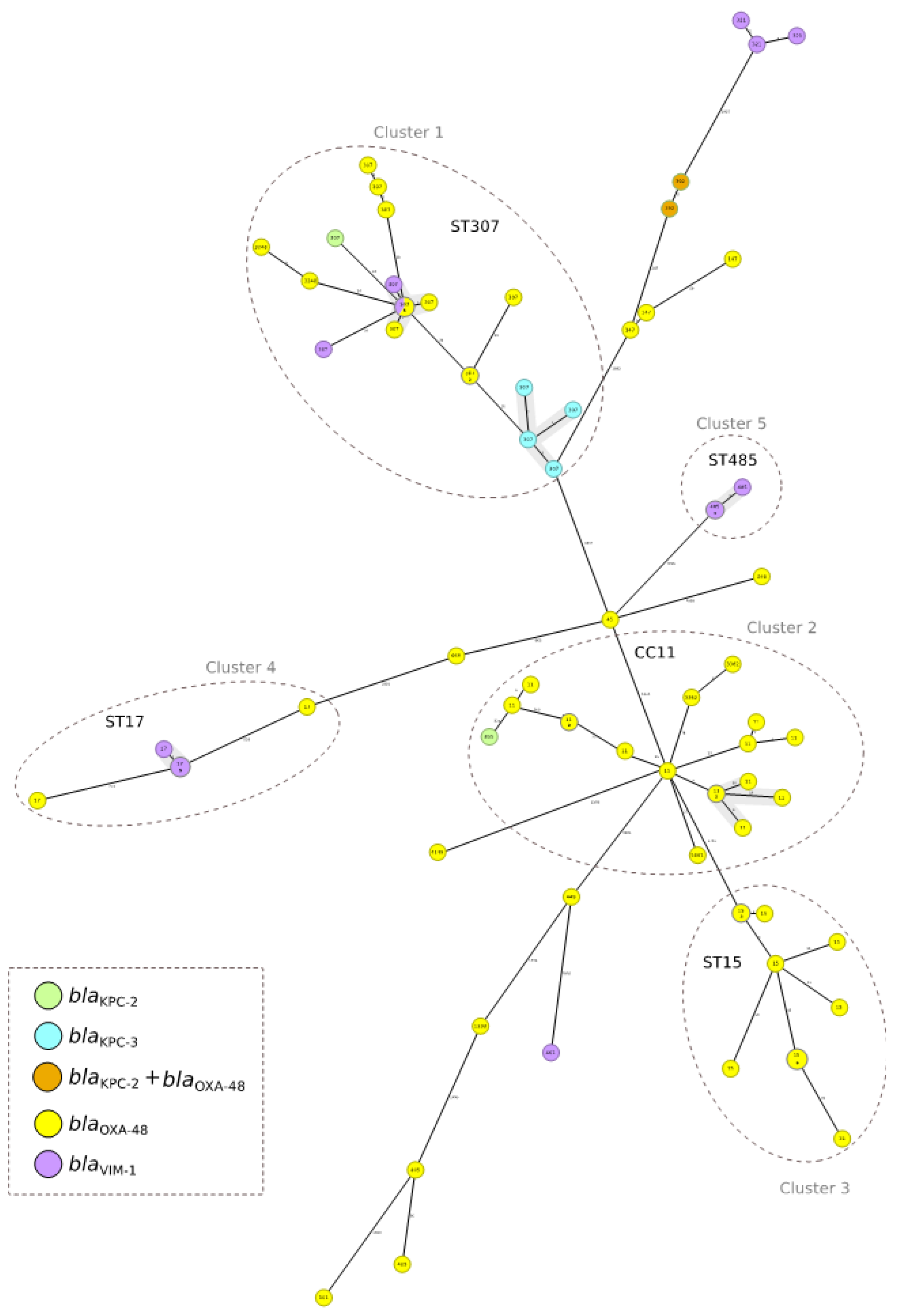
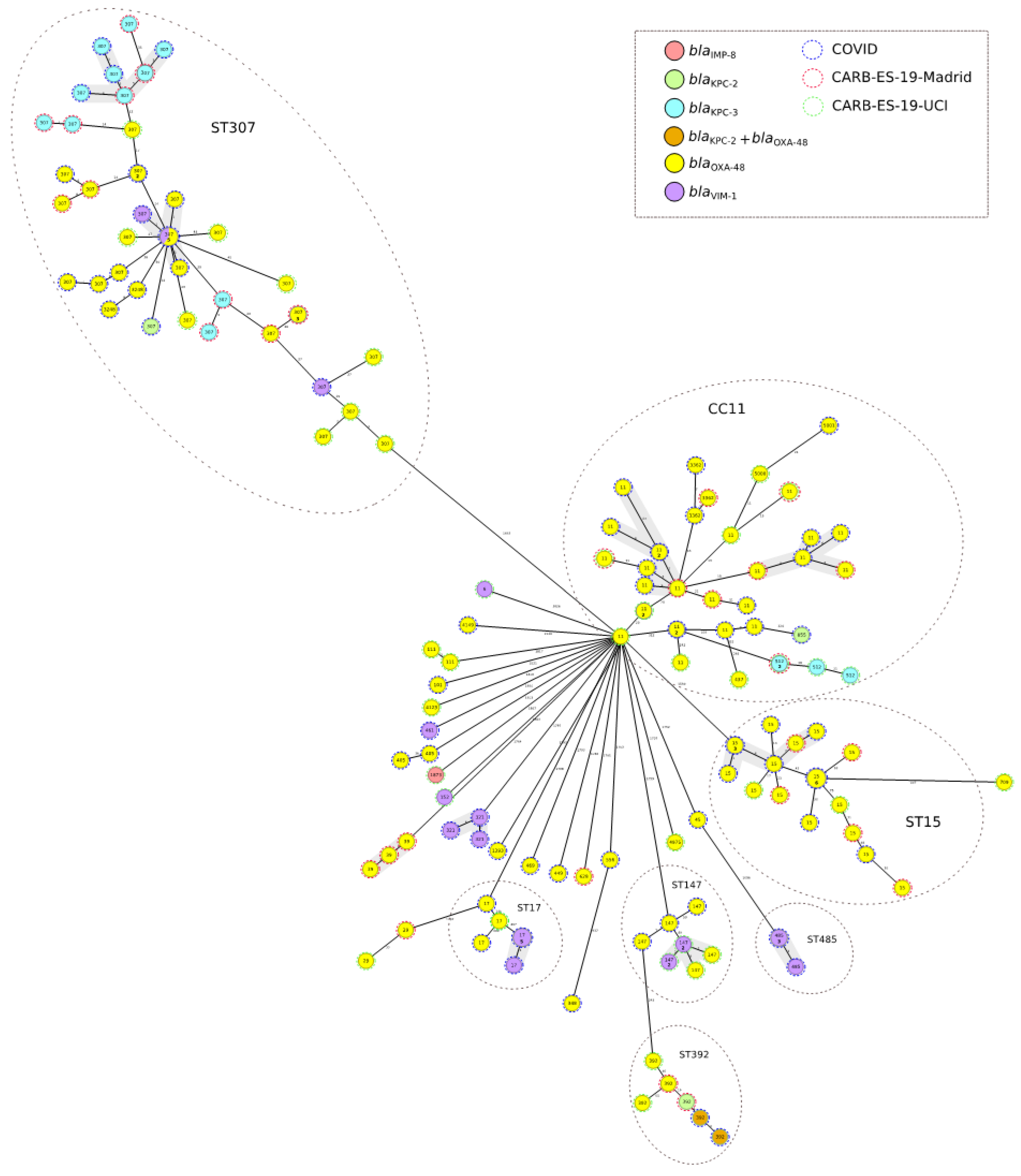
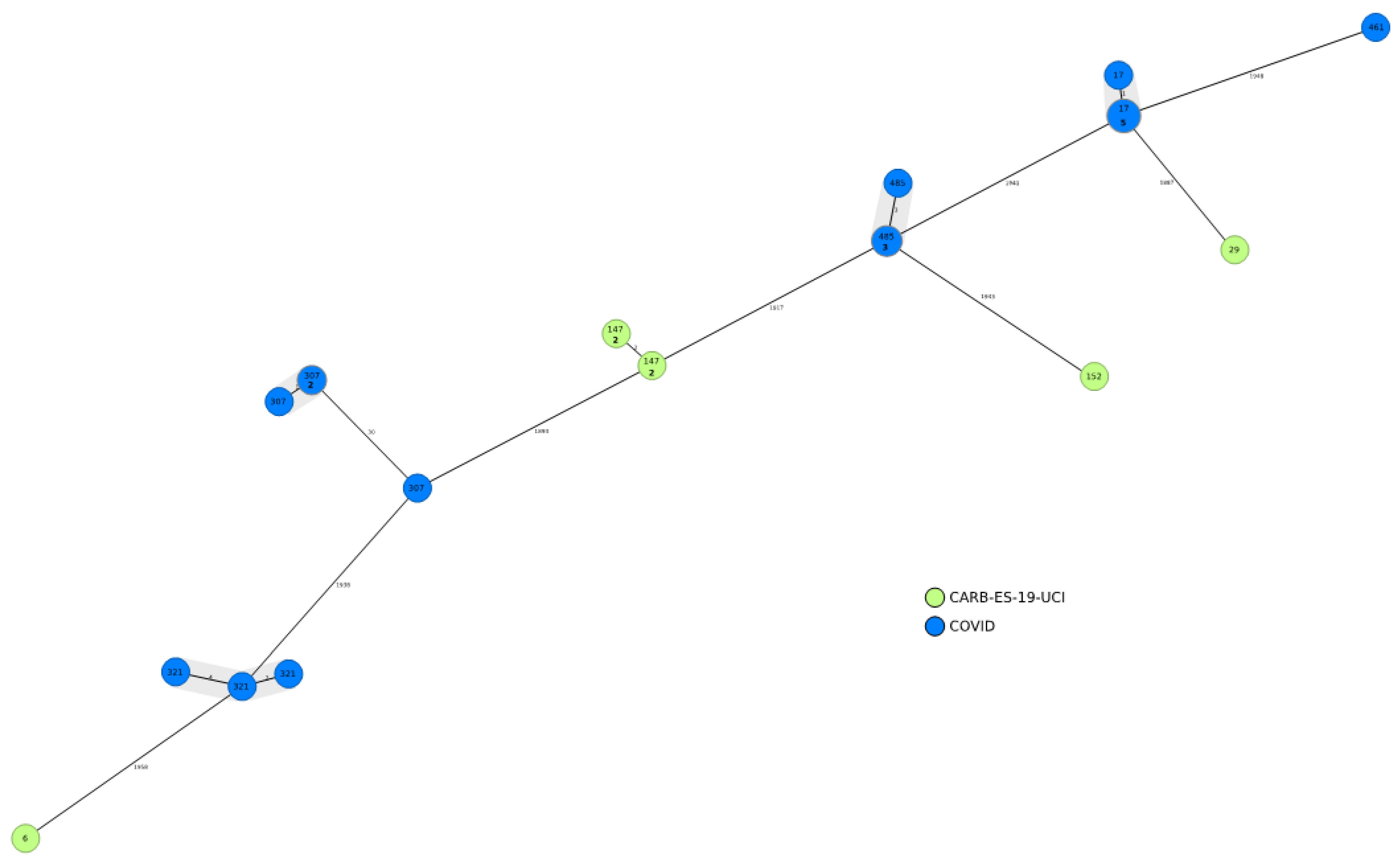
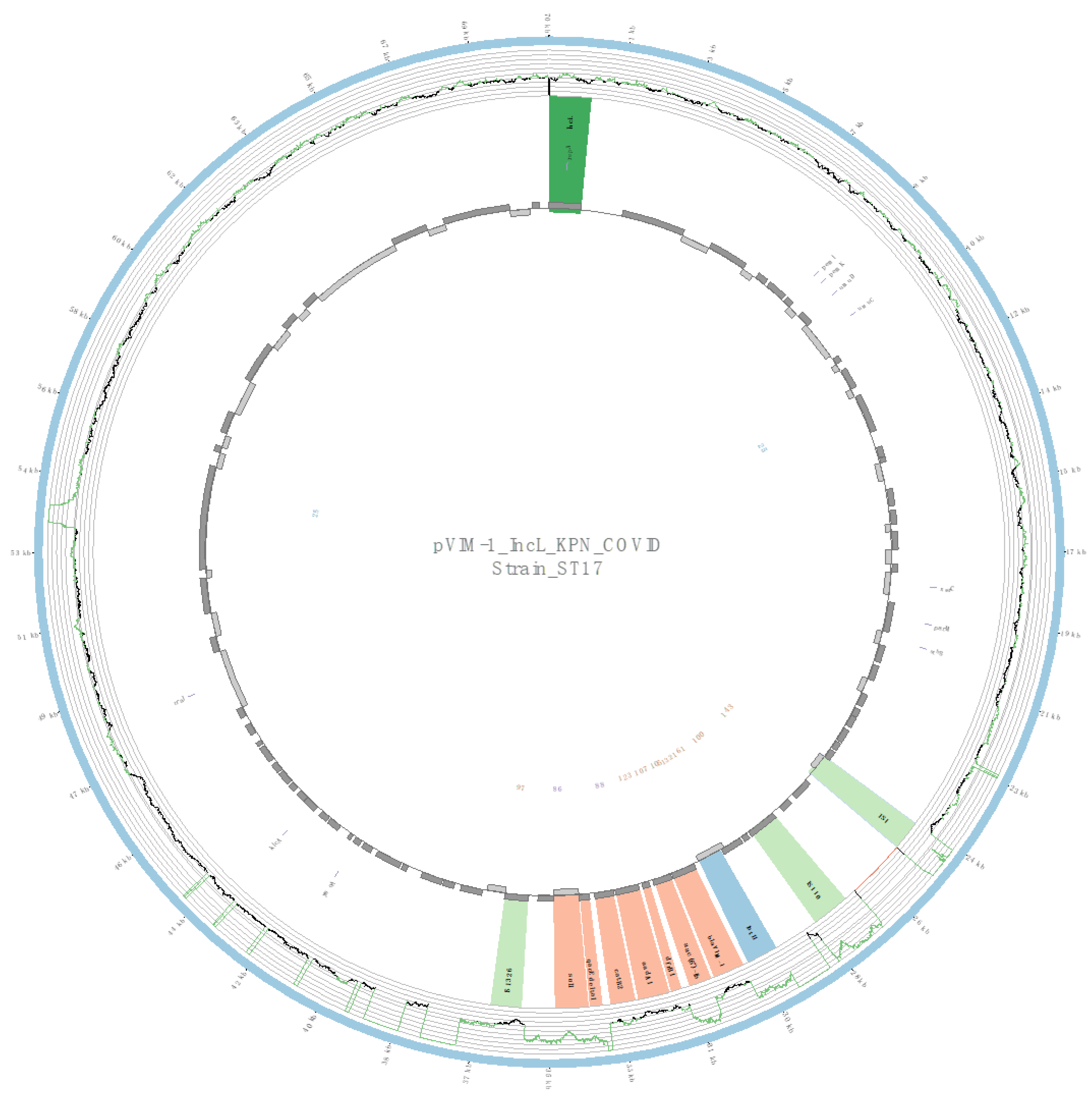
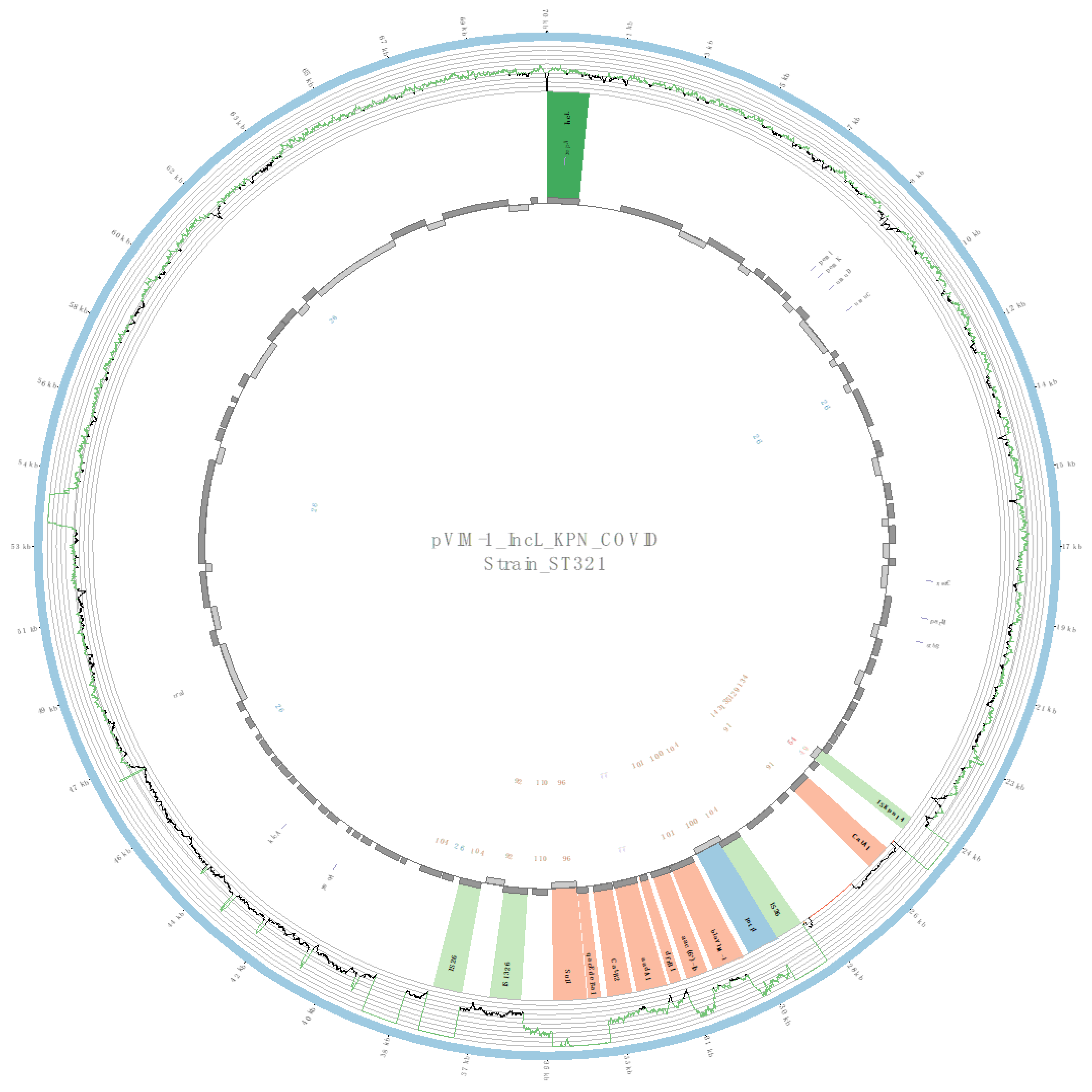
| CP-kpn COVID-19 (n = 85) | CP-kpn CARB-ES-19 Madrid (n = 34) | CP-kpn CARB-ES-19 UCIs (n = 40) | |||||||||||||
|---|---|---|---|---|---|---|---|---|---|---|---|---|---|---|---|
| Antibiotics | S (%) | R (%) | MIC50 a | MIC90 a | Range a | S (%) | R (%) | MIC50 a | MIC90 a | Range a | S (%) | R (%) | MIC50a | MIC90 a | Range a |
| Cefiderocol * | 98.8 | 1.2 | 0.064 | 0.64 | ≤0.015 to 4 | 97.3 | 2.9 | 0.06 | 0.25 | ≤0.015 to 4 | 100 | 0 | 0.12 | 0.5 | ≤0.015 to 1 |
| Plazomicin ** | 97.6 | 1.2 | 0.5 | 1 | 0.125 to 8 | 100 | 0 | 1 | 2 | 0.25 to 2 | 97.5 | 2.5 | 1 | 1 | 0.5 to 8 |
| Colistin | 85.9 | 14.1 | 1 | >8 | 0.5 to 8 | 91.2 | 8.8 | 1 | 2 | 0.5 to >8 | 85 | 15 | 1 | >8 | 0.5 to >8 |
| Meropenem/vaborbactam * | 87.1 | 12.9 | 1 | 64 | 0.032 to >64 | 82.4 | 17.6 | 1 | 16 | 0.015 to 128 | 92.5 | 7.5 | 0.5 | 8 | 0.03 to >64 |
| Ceftazidime/avibactam | 78.8 | 21.2 | 2 | >16 | ≤0.5 to >16 | 100 | 0 | 2 | 8 | ≤0.5 to 8 | 72.5 | 27.5 | 2 | >16 | ≤0.5 to >16 |
| Imipenem/relebactam * | 82.4 | 17.6 | 1 | >32 | 0.125 to >32 | 73.5 | 26.5 | 1 | >32 | 0.5 to >32 | 77.5 | 22.5 | 1 | 32 | 0.25 to >32 |
| Amikacin | 80 | 11.8 | ≤4 | 32 | 4 to >32 | 76.5 | 23.5 | 8 | 16 | ≤4 to >32 | 72.5 | 27.5 | 8 | 32 | ≤4 to >32 |
| Imipenem | 41.2 | 28.2 | 4 | 16 | ≤0.5 to >16 | 52.9 | 35.3 | 2 | >16 | ≤0.5 to >16 | 57.5 | 35 | 2 | >16 | 1 to >16 |
| Meropenem | 37.6 | 22.4 | 2 | >16 | 0.5 to >16 | 52.9 | 20.6 | 2 | >16 | 0.5 to >16 | 50 | 32.5 | 4 | >16 | 0.5 to >16 |
| Gentamicin | 43.5 | 49.4 | 4 | >8 | ≤0.5 to >8 | 32.3 | 67.6 | >8 | >8 | ≤0.5 to >8 | 40 | 60 | >8 | >8 | ≤0.5 to >8 |
| Cotrimoxazole | 20 | 76.5 | >8 | >8 | ≤1 to >8 | 17.6 | 82.4 | >8 | >8 | ≤1 to >8 | 32.5 | 67.5 | >8 | >8 | ≤1 to >8 |
| Tobramycin | 24.7 | 75.3 | >8 | >8 | ≤1 to >8 | 17.6 | 82.4 | >8 | >8 | ≤1 to >8 | 27.5 | 72.5 | >8 | >8 | ≤1 to >8 |
| Aztreonam | 14.1 | 84.7 | >32 | >32 | 0.5 to >32 | 8.8 | 91.2 | >32 | >32 | ≤0.5 to >32 | 17.5 | 75 | >32 | >32 | ≤0.5 to >32 |
| Cefepime * | 4.7 | 82.4 | 16 | >256 | 0.025 to >256 | 8.8 | 85.3 | 64 | >256 | 0.25 to >256 | 15 | 85 | 32 | >256 | 0.25 to >256 |
| Ceftazidime | 4.7 | 92.9 | >16 | >16 | ≤0.5 to >16 | 2.9 | 91.2 | >16 | >16 | 1 to >16 | 17.5 | 82.5 | >16 | >16 | ≤0.5 to >16 |
| Ceftolozane/tazobactam | 4.7 | 95.3 | >32 | >32 | 1 to >32 | 2.9 | 97.1 | >32 | >32 | 2 to >32 | 12.5 | 87.5 | >32 | >32 | ≤0.5 to >32 |
| Cefotaxime | 1.2 | 95.3 | >8 | >8 | 1 to >8 | 0 | 97.1 | >8 | >8 | 2 to >8 | 5 | 85 | 32 | >256 | 0.25 to >256 |
| Ciprofloxacin | 7.1 | 92.9 | >2 | >2 | ≤0.06 to >2 | 0 | 100 | >2 | >2 | >2 | 10 | 87.5 | >2 | >2 | ≤0.06 to >2 |
| Ertapenem | 2.4 | 96.5 | >2 | >2 | 0.5 to >2 | 0 | 100 | >2 | >2 | 1 to >2 | 2.5 | 97.5 | >2 | >2 | 0.5 to >2 |
| Susceptibility (%) in CP-kpn COVID-19 | |||
|---|---|---|---|
| Antibiotics | OXA-48-Group Producing Isolates (n = 59) | KPC-Group Producing Isolates (n = 6) | VIM-Group Producing Isolates (n = 18) |
| Cefiderocol * | 98.3 | 100 | 100 |
| Plazomicin ** | 96.6 | 100 | 100 |
| Colistin | 86.4 | 66.7 | 100 |
| Meropenem/vaborbactam * | 88.1 | 100 | 77.8 |
| Ceftazidime/avibactam | 100 | 100 | 0 |
| Imipenem/relebactam * | 88.1 | 100 | 55.6 |
| Amikacin | 84.7 | 66.7 | 66.7 |
| Imipenem | 57.6 | 0 | 5.6 |
| Meropenem | 49.2 | 0 | 16.7 |
| Gentamicin | 50.8 | 50 | 22.2 |
| Cotrimoxazole | 25.4 | 33.3 | 0 |
| Tobramycin | 32.2 | 33.3 | 0 |
| Aztreonam | 6.8 | 0 | 44.8 |
| Cefepime * | 6.8 | 0 | 0 |
| Ceftazidime | 6.8 | 0 | 0 |
| Ceftolozane/tazobactam | 6.8 | 0 | 0 |
| Cefotaxime | 1.7 | 0 | 0 |
| Ciprofloxacin | 8.5 | 0 | 5.6 |
| Ertapenem | 0 | 0 | 11.1 |
| CP-Kpn COVID-19 | CP-Kpn Madrid- CARB-ES-19 | CP-Kpn ICU- CARB-ES-19 | |
|---|---|---|---|
| Number of isolates | 84 | 34 | 40 |
| Number of STs | 20 | 9 | 18 |
| Average of isolates per ST (range) | 4.2 (1–20) | 3.8 (1–13) | 2.2 (1–9) |
| Number of single isolates by ST (%) | 9 (10.7) | 3 (8.8) | 11 (27.5) |
| SDI | 23.8 | 26.5 | 45 |
| OXA-48 (%) | 60 (71.4) | 25 (73.5) | 27 (67.5) |
| KPC (%) | 8 (9.5) | 10 (29.4) | 5 (12.5) |
| NDM (%) | 0 | 0 | 0 |
| VIM (%) | 18 (21.4) | 0 | 7 (17.5) |
| IMP (%) | 0 | 0 | 1 (2.5) |
| ST307; n (%); carb. types | 20 (23.8); OXA-48 (11), VIM-1 (4), KPC-3 (4), KPC-2 (1) | 13 (38.2); KPC-3 (7), OXA-48 (6) | 9 (22.5); OXA-48 (8), KPC-3 (1) |
| ST15; n (%); carb. types | 15 (17.8); OXA-48 | 5 (14.7); OXA-48 | 2 (5); OXA-48 (2) |
| ST11; n (%); carb. types | 14 (16.6); OXA-48 | 6 (17.6); OXA-48 | 7 (17.5); OXA-48 (6), KPC-2 (1) |
| ST17; n (%); carb. types | 8 (9.5); VIM-1 (6), OXA-48 (2) | 0 | 1 (2.5); OXA-48 |
| ST147; n (%); carb. types | 3 (3.6); OXA-48 | 0 | 4 (10); VIM-1 |
| ST512; n (%); carb. types | 0 | 2 (5.9); KPC-3 | 3 (7.5); KPC-3 |
| ST485; n (%); carb. types | 4 (4.8); VIM-1 | 0 | 0 |
| ST39; n (%); carb. types | 0 | 3 (8.8); (OXA-48) | 0 |
| Type of Resistance | Resistance Genes | % CP-kpn COVID-19 (n = 85) | % CP-kpn CARB-ES-19 Madrid (n = 34) | % CP-kpn CARB-ES-19 UCIs (n = 40) |
|---|---|---|---|---|
| ESBL | blaCTX-M-15 | 76.1 | 76.5 | 52.5 |
| blaCTX-M-9 | 2.4 | 0 | 5 | |
| blaSHV-12 | 2.4 | 0 | 5 | |
| blaSHV-2 | 1.2 | 0 | 0 | |
| blaCTX-M-65 | 0 | 0 | 2.5 | |
| Aminoglycoside | aac(6′)-Ib-cr | 50 | 64.7 | 45 |
| aac(3)-IIa | 33.3 | 58.8 | 42.5 | |
| aac(6′)-Ib | 19 | 2.9 | 22.5 | |
| aph | 70.2 | 82.3 | 55 | |
| aph (3``)-Ib/aph (6)-Id * | 53.6 | 67.6 | 42.5 | |
| Chloramphenicol | cat | 40.5 | 70.5 | 70 |
| catA1 * | 22.6 | 0 | 0 | |
| catB3 * | 0 | 67.7 | 42.5 | |
| Sulfonamides | sul | 75 | 76.4 | 72.5 |
| sul1 | 42.8 | 14.7 | 42.5 | |
| sul2 | 55.9 | 67.6 | 40 | |
| Trimethoprim | dfr | 86.9 | 82.3 | 65 |
| dfrA14 * | 44 | 67.5 | 42.5 | |
| Tetracyclines | tet | 42.8 | 26.5 | 32.5 |
| tetA * | 36.9 | 26.5 | 30 | |
| Colistin | mcr | 2.4 | 0 | 5 |
| mcr-9 * | 2.4 | 0 | 5 | |
| Quinolone | qnr-like | 45.2 | 61.8 | 50 |
| qnrB1-like * | 22.6 | 61.8 | 42.5 |
Disclaimer/Publisher’s Note: The statements, opinions and data contained in all publications are solely those of the individual author(s) and contributor(s) and not of MDPI and/or the editor(s). MDPI and/or the editor(s) disclaim responsibility for any injury to people or property resulting from any ideas, methods, instructions or products referred to in the content. |
© 2023 by the authors. Licensee MDPI, Basel, Switzerland. This article is an open access article distributed under the terms and conditions of the Creative Commons Attribution (CC BY) license (https://creativecommons.org/licenses/by/4.0/).
Share and Cite
Cañada-García, J.E.; Ramírez de Arellano, E.; Jiménez-Orellana, M.; Viedma, E.; Sánchez, A.; Alhambra, A.; Villa, J.; Delgado-Iribarren, A.; Bautista, V.; Lara, N.; et al. Carbapenemase-Producing Klebsiella pneumoniae in COVID-19 Intensive Care Patients: Identification of IncL-VIM-1 Plasmid in Previously Non-Predominant Sequence Types. Antibiotics 2023, 12, 107. https://doi.org/10.3390/antibiotics12010107
Cañada-García JE, Ramírez de Arellano E, Jiménez-Orellana M, Viedma E, Sánchez A, Alhambra A, Villa J, Delgado-Iribarren A, Bautista V, Lara N, et al. Carbapenemase-Producing Klebsiella pneumoniae in COVID-19 Intensive Care Patients: Identification of IncL-VIM-1 Plasmid in Previously Non-Predominant Sequence Types. Antibiotics. 2023; 12(1):107. https://doi.org/10.3390/antibiotics12010107
Chicago/Turabian StyleCañada-García, Javier E., Eva Ramírez de Arellano, Miguel Jiménez-Orellana, Esther Viedma, Aida Sánchez, Almudena Alhambra, Jennifer Villa, Alberto Delgado-Iribarren, Verónica Bautista, Noelia Lara, and et al. 2023. "Carbapenemase-Producing Klebsiella pneumoniae in COVID-19 Intensive Care Patients: Identification of IncL-VIM-1 Plasmid in Previously Non-Predominant Sequence Types" Antibiotics 12, no. 1: 107. https://doi.org/10.3390/antibiotics12010107
APA StyleCañada-García, J. E., Ramírez de Arellano, E., Jiménez-Orellana, M., Viedma, E., Sánchez, A., Alhambra, A., Villa, J., Delgado-Iribarren, A., Bautista, V., Lara, N., García-Cobos, S., Aracil, B., Cercenado, E., Pérez-Vázquez, M., & Oteo-Iglesias, J. (2023). Carbapenemase-Producing Klebsiella pneumoniae in COVID-19 Intensive Care Patients: Identification of IncL-VIM-1 Plasmid in Previously Non-Predominant Sequence Types. Antibiotics, 12(1), 107. https://doi.org/10.3390/antibiotics12010107







